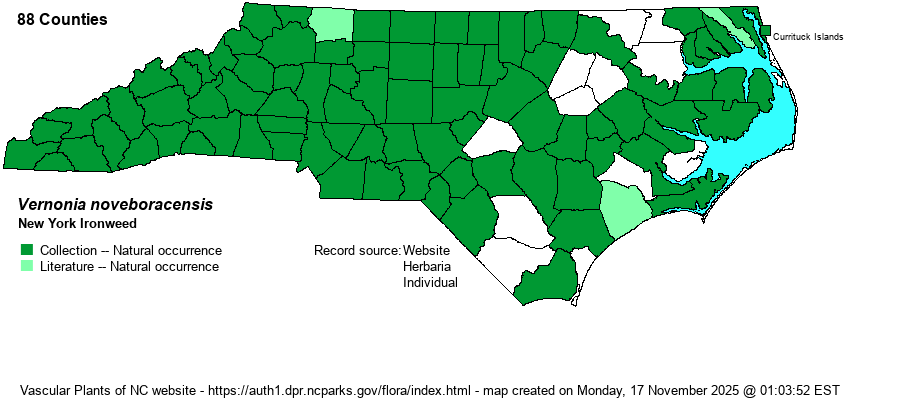| Author | (L.) Michaux | |
| Distribution | Throughout the state, except rare on the Outer Banks, and of spotty occurrence in the Coastal Plain. Likely occurs in all 100 counties.
MA and NY to WV and TN, south to northwestern FL and AL. | |
| Abundance | Common in the Mountains and Piedmont; infrequent to locally common in most of the Coastal Plain, but infrequent in the Sandhills. Less numerous in the Coastal Plain than upstate. | |
| Habitat | Wet to moist soil of marshes, river and stream shores, openings in bottomlands, wet meadows and pastures, roadside ditches, and damp powerline clearings. |
| Phenology | Flowering and fruiting July-September. | |
| Identification | New York Ironweed routinely reaches 6 feet tall, and may reach 8 feet. Leaves are numerous, narrowly elliptical, tapered to both ends, and the margins have small teeth. The open inflorescence supports a great number of pink to red-purple heads, though ray flowers are absent. It is best told from the rare Giant Ironweed (V. gigantea) -- essentially montane in NC -- by the latter having fewer-flowered heads (9-30 vs. 30-50) and acute to blunt tips of involucral bracts (vs. acuminate in New York Ironweed). As this species often grows in colonies or large stands, it is one of our most beautiful wildflowers. Stands of the plants in bloom are great attractants of butterflies, moths, and other insects for their nectar. | |
| Taxonomic Comments | None
| |
| Other Common Name(s) | None | |
| State Rank | S5 | |
| Global Rank | G5 | |
| State Status | | |
| US Status | | |
| USACE-agcp | FACW link |
| USACE-emp | FACW link |

